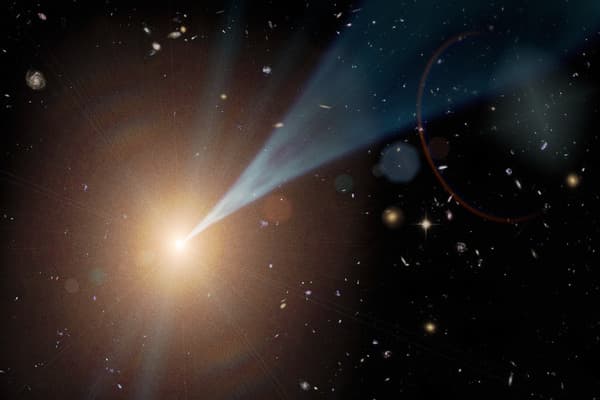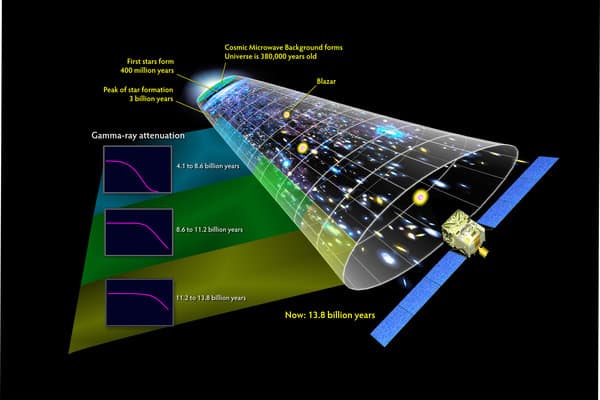NASA's Fermi Telescope Catches Unexpected Gamma Ray Bursts From a Supermassive Black Hole
Have you ever dreamed of going back in time and catching a glimpse of the ancient universe? Sounds like a science fiction film, right? Well, astronomers are doing it almost all the time. Highly energetic gamma rays from a distant galaxy that started their journey a long time ago, were recently detected by NASA's Fermi Gamma-ray Space Telescope. Since it takes 7 million years for light from that galaxy to reach Earth, the scientists were actually observing the surroundings of a black hole as it was 7 millions years back! The observations were able to throw light on the state of the cosmos 7 million years ago.

Fig: Black Hole Powered Galaxy - Blazars
Interestingly, Professor Jonathan Biteau, a French physicist was amazed to see unexpected results derived from Fermi’s detection. Till now, it was predicted that different energies are produced at different distances from the black hole and that the highest energy electromagnetic radiation i.e. Gamma rays are produced from regions having closest proximity to the black hole. But the composite wavelength picture received here, confirmed that light of all wavelengths originated from a single point located 5 light years away from the black hole.
Calculations showed that the light came from a blazar type Galaxy named PKS 1441+25. Like most galaxies, the centre of the PKS 1441+25 is home to a supermassive black hole weighing 70 million times that of our own sun. It is surrounded by a disk of hot gas and dust known as an accretion disk. When material in the disk falls towards the black hole, dual particle jets are formed which blast out of the disk in opposite directions and thereby give the scientists a golden opportunity to delve into the poorly understood realms of the black hole.

Fig: Gamma ray detection technique
This April, the PKS 1441+25 underwent a major eruption. Luigi Pacciani of the Italian National Institute for Astrophysics in Rome was heading a project to detect blazar flares in their earliest stages in association with the<a href="https://magic.mpp.mpg.de/" target="_blank" rel="nofollow noopener noreferrer">Home | MAGIC</a>Major Atmospheric Gamma-ray Imaging Cerenkov experiment (<a href="https://magic.mpp.mpg.de/" target="_blank" rel="nofollow noopener noreferrer">Home | MAGIC</a>), located on La Palma in the Canary Islands. Gamma rays of energy up to a staggering 33 billion GeV were detected by Fermi's Large area telescope during the explosion. After the Fermi discovery, the MAGIC team turned to the blazar and<a href="https://iopscience.iop.org/article/10.1088/2041-8205/815/2/L23" target="_blank" rel="nofollow noopener noreferrer">VERY HIGH ENERGY γ-RAYS FROM THE UNIVERSE'S MIDDLE AGE: DETECTION OF THE z = 0.940 BLAZAR PKS 1441+25 WITH MAGIC - IOPscience</a> with energies ranging from 40 to 250 GeV.
PKS 1441+25 is one among two such distant sources for which gamma rays with energies above 100 GeV have been observed. Its energetic bursts provides a never seen before glimpse into the intensity of the EBL spanning through a huge wavelength spectrum and suggests that most such radiation sources have already been identified.
Take a look at the following video where NASA Goddard describes the Blazar Bonanza -
Source: #-Link-Snipped-#

Fig: Black Hole Powered Galaxy - Blazars
Interestingly, Professor Jonathan Biteau, a French physicist was amazed to see unexpected results derived from Fermi’s detection. Till now, it was predicted that different energies are produced at different distances from the black hole and that the highest energy electromagnetic radiation i.e. Gamma rays are produced from regions having closest proximity to the black hole. But the composite wavelength picture received here, confirmed that light of all wavelengths originated from a single point located 5 light years away from the black hole.
Calculations showed that the light came from a blazar type Galaxy named PKS 1441+25. Like most galaxies, the centre of the PKS 1441+25 is home to a supermassive black hole weighing 70 million times that of our own sun. It is surrounded by a disk of hot gas and dust known as an accretion disk. When material in the disk falls towards the black hole, dual particle jets are formed which blast out of the disk in opposite directions and thereby give the scientists a golden opportunity to delve into the poorly understood realms of the black hole.

Fig: Gamma ray detection technique
This April, the PKS 1441+25 underwent a major eruption. Luigi Pacciani of the Italian National Institute for Astrophysics in Rome was heading a project to detect blazar flares in their earliest stages in association with the<a href="https://magic.mpp.mpg.de/" target="_blank" rel="nofollow noopener noreferrer">Home | MAGIC</a>Major Atmospheric Gamma-ray Imaging Cerenkov experiment (<a href="https://magic.mpp.mpg.de/" target="_blank" rel="nofollow noopener noreferrer">Home | MAGIC</a>), located on La Palma in the Canary Islands. Gamma rays of energy up to a staggering 33 billion GeV were detected by Fermi's Large area telescope during the explosion. After the Fermi discovery, the MAGIC team turned to the blazar and<a href="https://iopscience.iop.org/article/10.1088/2041-8205/815/2/L23" target="_blank" rel="nofollow noopener noreferrer">VERY HIGH ENERGY γ-RAYS FROM THE UNIVERSE'S MIDDLE AGE: DETECTION OF THE z = 0.940 BLAZAR PKS 1441+25 WITH MAGIC - IOPscience</a> with energies ranging from 40 to 250 GeV.
PKS 1441+25 is one among two such distant sources for which gamma rays with energies above 100 GeV have been observed. Its energetic bursts provides a never seen before glimpse into the intensity of the EBL spanning through a huge wavelength spectrum and suggests that most such radiation sources have already been identified.
Take a look at the following video where NASA Goddard describes the Blazar Bonanza -
Source: #-Link-Snipped-#
0

